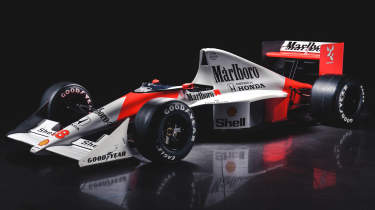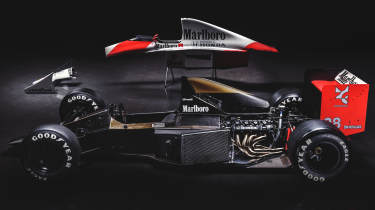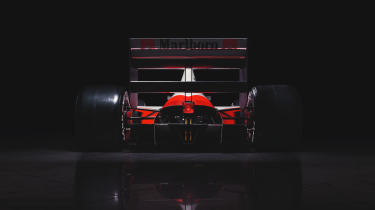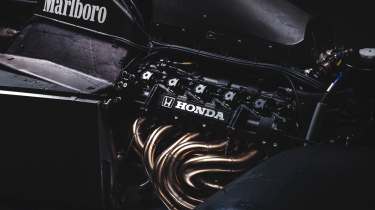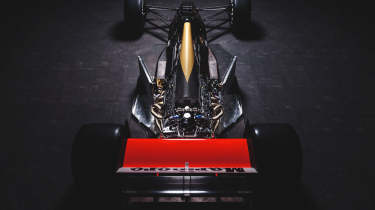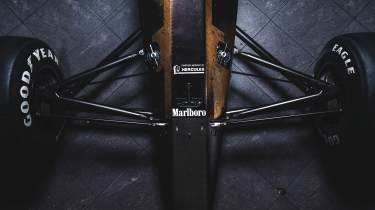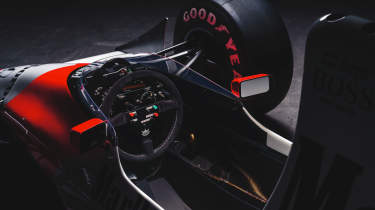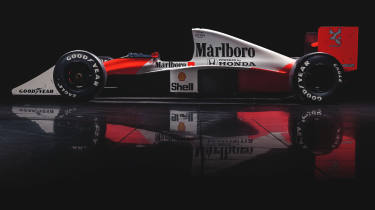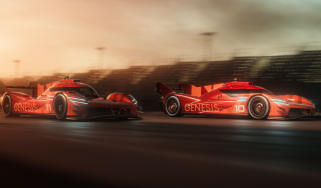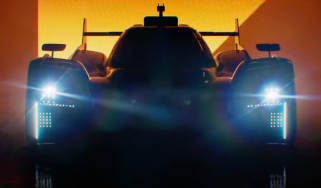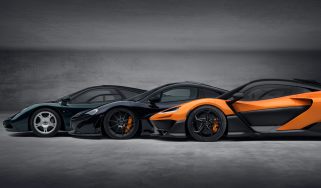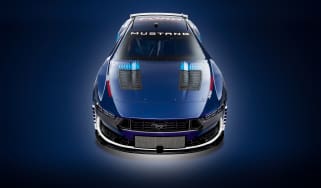McLaren-Honda MP4/5B: Anatomy of a V10 F1 champion
McLaren and Honda went the V10 route when F1 returned to natural aspiration. The resulting MP4/5 and MP4/5B were championship-winning titans
By the mid-1980s the power outputs of turbocharged F1 cars had gone berserk. From being little more than a curiosity barely five years previously, now you had to have one of the little 1.5-litre turbocharged engines if you hoped to win a race, and indeed by 1986 the turbo route was the only one allowed by the rules. Up to 1000bhp was often available in race trim, with as much as 1500bhp during qualifying – but only for one lap or so, before the engine was little more than a coffee table.
The sport’s governing body decided to act, and announced that naturally aspirated engines would be making a comeback alongside the turbo engines for 1987, with turbos banned completely from 1989. They would be of 3.5-litre capacity, unlike the 3-litre limit hitherto in place for NA engines since 1966’s ‘return to power’.
During ’87 the turbo cars had to run with a new 4 bar boost limit, but for 1988 the picture changed again, as boost was reduced to a maximum of 2.5 bar and fuel allowance cut to just 150 litres for a race. Now the 3.5-litre cars were more competitive, with teams so-equipped, such as Williams and Leyton House March, running in the top six. Out of the turbo runners, only Honda really took this final year of engine development seriously, given that turbos would be banned altogether for the 1989 season, and subsequently reaped the rewards by winning 15 out of 16 races with its 650bhp unit in the back of the McLaren MP4/4.
For 1989 the pitlane resonated once again with the ear-splitting shriek of high-revving, large-capacity V8s, V10s and V12s. Nevertheless, McLaren was still the class of the field, the title being fought out between its drivers Ayrton Senna and Alain Prost, the contest coming to a head with a collision at Suzuka and the crown going to the Frenchman. That McLaren was the MP4/5, and as the 1990 season dawned, the team unveiled an updated version, known as the MP4/5B – the car you see here. It would go on to take the drivers’ title in the hands of Ayrton Senna, and in the most controversial of circumstances.
The 3.5-litre era saw incredible development. Having started out with relatively straightforward cars that owed a lot to the turbo era but with a big, NA engines fitted, by 1993 they were among the most sophisticated the sport has ever seen, with their active suspensions, semi-automatic gearboxes, traction control and so on. Then for the final year most of those gizmos were removed, leaving these brutal cars a real handful. Whether that contributed to the tragedies of that season is a moot point, but soon aero and power would be reduced, and safety greatly increased. For 1995 a 3-litre displacement cap was introduced.
Chassis MP4/5B-03
The MP4/5B was the work of Neil Oatley and a crack design team at McLaren, with Honda engine development headed up by Osamu Goto in Japan. Oatley had joined McLaren at the end of 1986, and in fact still works at McLaren as director of design and development. Steve Nichols had designed the MP4/4, with the plan being that he and Oatley would take it in turn to design successive McLarens after that (except Nichols then left with Prost for Ferrari). ‘It’s one of my favourite cars,’ says Oatley with affection, ‘and I’ve still got the wind tunnel model of it in my house.’
MP4/5B chassis 03 has led an eventful life. Its initial role was as a ‘T’ car (back in the era when F1 teams took a spare car to races) for Ayrton Senna until the Monaco Grand Prix, where having been driven by Senna in practice, it was suddenly called into action when Senna’s teammate Gerhard Berger attempted an outrageously optimistic move on Alain Prost’s Ferrari, causing an inevitable shunt and blocking the track. With the race stopped, Berger ran back to the pits and jumped into 03. Despite it having been set up for Senna (who was much shorter in stature than the Austrian), Berger put in a feisty performance, bringing the car home in third position right behind Jean Alesi’s Tyrrell and winner Senna. The car was then used as a test and development car for McLaren’s embryonic active suspension and semi-automatic gearbox until being retired in late 1991.
Body and aerodynamics
Like every other Formua 1 car by the turn of the 1990s, the MP4/5B uses a carbonfibre tub structure as the basis for its chassis with the engine a fully stressed member, the last aluminium honeycomb chassis being phased out in the mid-’80s. However, while the driver’s feet were now behind the front axle line, and there was considerably more strength to the monocoque, just one glance at the car shows that the driver is exposed from the shoulders upwards in a side impact. The flipside, of course, was that the spectator had an almost unhindered view of the stars of the day at work in the cockpit. It’s also obvious just how simple the surfaces of the car are, compared with the cars of today, and the lack of any trick aero devices.
It would take the unlikely form of the Leyton House March 881 to shift F1 thinking. The small British team, funded by Japanese property mogul and motorsport fan Akira Akagi, employed a young Adrian Newey to design its second F1 car, for the 1988 season, and his needle-nosed, narrow-tubbed and raised-front-floor design would set the template for F1 cars for years to come, marking him out as a talent to watch in the process. Nevertheless, Oatley was aware of the new era coming. ‘Other cars were becoming competitive, like Adrian’s Leyton House; we felt we lacked downforce,’ he says. ‘So on the 5B we had a fairly complex floor and rear diffuser – it was known as the Bat Floor because of the shape from the rear. It was efficient but we didn’t have the analysis tools [they started to come the year after], so the car was difficult to set up to make the most of the downforce. After the Silverstone race we went back to a hybrid diffuser from ’89 and the car became a lot easier to set up and we became more competitive after that.’
> Penske PC23: the anatomy of a 253mph IndyCar icon
The other key car of 1990 was the beautiful Tyrell 019, designed by legendary British engineer Dr Harvey Postlethwaite, and driven by an emergent Jean Alesi. Despite ‘only’ having a Cosworth DFR in the back, this car proved a match for almost anyone on certain tracks thanks in part to its revolutionary high-nose concept: within five years every F1 car would have a high nose.
In the turbo years, to make a car go faster teams had essentially run more boost and put an even bigger wing on the back; the 3.5-litre era saw the beginning of aerodynamic design playing an ever-increasing importance in the development of Grand Prix cars, and soon the simple shapes and flat surfaces would make way for far more intricate designs.
Engine, gearbox & electronics
One of the fascinating aspects of the 3.5-litre era is the variety in terms of engine configuration. Unlike today’s prescriptive rules, which effectively ensure that every manufacturer fields an almost identical 1.6-litre V6, back in the late ’80s and early ’90s F1 engine builders had an almost free hand to design what they liked. This led to a multitude of different engines, with their plus and minus points, and of course, a good number of different signature sounds for the fans.
Simply put, the V8 route offered the best low-down torque (relatively speaking of course: these were still very peaky racing thoroughbreds) and also the lowest fuel consumption. A V8 also typically required less cooling, which exaggerated the inherent weight advantage of a smaller engine in the first place. It was, though, the least powerful option, with early Cosworth DFRs making around 600bhp, and even the championship-winning Ford Zetec-R of 1994 in the back of Michael Schumacher’s Benetton perhaps no more than 750bhp.
At the other end of the scale, the 12-cylinder route offered the best power along with the highest rev limit. Initially, Ferrari was the only team to follow this route, but in time Honda would join them (perhaps determined to wrest the outright power mantle from them), as would Lamborghini and Yamaha. By 1994, the formula’s final year, the Ferrari V12 was said to be producing as much as 850bhp. However, internal friction was high, and the weight of the engine, its associated cooling components, its oil and fuel consumption, along with a weaker torque delivery, all had an effect on chassis design and made the car less driveable in certain ways. The less said about period curios, Porsche’s bloated V12, the Subaru flat-12 and the Life W12, the better, all candidates for arguably the worst F1 cars of all time.
That left the V10 as arguably the best compromise, and indeed, in time it would become the preferred option, finally being cemented into the rules as the only engine configuration from the 2000 season onwards.
For 1990 Honda introduced the RA100E version of its V10. Sharing the same 3490cc capacity and 72-degree V-angle as 1989’s RA109E, it generated close to 700bhp and revved out to 13,500rpm while still using conventional valve springs. It was rival Renault that introduced pneumatic valve technology, enabling higher rev limits, which would reach their peak over a decade later when the ultimate 3-litre V10s hit 20,000rpm. Still, despite its compromises, Honda’s engine probably led the pack and, as Allan McNish mentions later in this story, was superbly tractable and driveable as well as delivering immense top-end power. Want to gauge it’s true ferocity? Search for the in-car footage of Senna and Berger at Monaco that year. It’s angry…
Like almost every other car in the field, the McLaren MP4/5B used a conventional manual (six-speed) gearbox, previously mounted longitudinally but transverse by the time the B model was introduced. However, a year earlier Ferrari had taken the brave step of debuting the first semi-automatic paddleshift box in F1, its unreliability costing the team a realistic shot at that year’s title. It wouldn’t be long though before every F1 car on the grid had a semi-auto ’box, a testament to the inherent rightness of the idea. As it was, rev matching was vital, and as Oatley says, ‘The gearshift was always a pain – there was always a risk of damaging the ’box.’ The 5B has quite a long, deliberate gearshift throw, apparently at the behest of Senna. ‘Ayrton had a very good feeling for the car, and was consistently trying to make it a consistent race car over a race distance [during development],’ adds Oatley. By 1993, F1 cars would be laden with electronics, which strikes a contrast with the relatively simple technology within the 5B.
Suspension, tyres and brakes
The 5B uses a pullrod front suspension set-up with double wishbones front and rear. Despite Williams having used a form of active suspension in 1987, the 1990 McLaren was entirely passive, but this actual car then went on to test McLaren’s own active system, introduced in 1993. By then Williams’ FW14B had dominated the 1992 championship in part thanks to its active suspension system, an advantage it kept through ’93 when Alain Prost took the title in the FW15. It was the removal of this tech, and the associated handling difficulties, that made the FW16 so difficult to drive even for Ayrton Senna at the beginning of the fatal 1994 season.
Like the majority of the rest of the field, the 5B ran on Goodyear tyres. However, there was competition in the form of Pirelli, whose rubber could be very fast in certain conditions. By now, every F1 car ran with carbon brakes.
Driving it
Allan McNish was racing in F3000 and had been runner-up the year previously in the British F3 Championship when he stepped into the MP4/5B for the first time as a McLaren test driver during 1990. ‘They were big, meaty cars, and you had to just tighten the belts and go for it,’ he recalls today. ‘They required a different skill-set to the cars of ten years later. Your risk management with these was higher – you could damage the engine, the gearbox; if you went off at Eau Rouge you were heading for Liège Hospital. The driver was like a gladiator. It was a dangerous era – the circuits took no prisoners.
‘The car was relatively stable. It had a chunk of downforce, maybe not that efficient, but it did have lots of power. It would tend to understeer not oversteer; it was quite point-and-squirt as a general rule, but did require a bit of work mid-corner. The engine was super tractable – you could take a hairpin in fourth gear if you needed to and it would still pick up. It really did have a honking load of horsepower. The throttle pedal travel was long – 90-100mm compared to 40mm later on – so you could really control it with your foot.
‘The steering wheel was huge, and it was quite a slow steering rack. Your inputs were quite benign compared to F3 or F3000 cars. You needed a lot of lock for a hairpin, and with no PAS plus a manual and heel and toe you had to have control of the wheel. The car would dance around a lot, but the big wheel was to make it comfortable.
‘Neil understood how to win races; he had loads of experience and didn’t create one-lap wonders. Data acquisition was so limited – it was hand-written notes between driver and engineer, so that relationship was key. You get used to the power and speed quickly, but it was the braking… I was used to steel brakes so the carbon brakes and the high-speed downforce was the thing. Your neck did feel it!’
Running it today & the marketplace
03 was sold from McLaren Racing’s extraordinary stash of past F1 chassis having lain dormant for 20 years, and handed to Paul Lanzante Ltd in 2018 for a complete nut-and-bolt restoration. It was stripped completely to a bare tub, deep cleaned and every last part crack tested where required, then either replaced, replated or painted as seen fit. The only missing parts were the pedal box and the gearbox internals, which Lanzante had remanufactured with the aid of the original drawings direct from McLaren Racing.
A few items around the Honda V10, such as the cable ties, weren’t available, and for this Lanzante’s Alan Murphy, who rebuilt the car over a period of three months, 3D protoyped on the basis of research. The car runs on a modern ECU, hidden inside the original box, and fresh slicks (inters and wets are available) of the correct size by Avon – despite what the logos say! Murphy added a fuel priming system, as the cars in period could lose pressure when waiting on the grid, and incorporated a water heater too. So equipped, the starting procedure is disarmingly simple: simply switch on the heater, go and have a cup of tea for 20 minutes, and when you return the V10 is good to fire.
In fact, running the car is nothing like the challenge you might expect. It’s been set up with a base setting suitable for most tracks, and the same applies to the gear ratios. The ride height is raised by 10mm to protect the floor, and there’s a bit less toe-in on the front to promote tyre life, but a couple of mechanics are all you’d need to run it. Holding back slightly on the revs for the fresh V10 should give plenty of track hours. The finished car is absolutely perfect, down to the last washer. To stand next to it is to feel its powerful aura; the thought that it’s ready to be driven hard simply blows the mind…
Girardo & Co sold 03 in the summer of 2022. Max Girardo feels the market is changing for F1 cars of this era: ‘There’s lots of interest now, even compared to five years ago. There was a time when people felt they were difficult to run and didn’t know what to do with them. Now there’s a real passion and love for the cars. It’s definitely a generational thing, and they’ve aged really well – they’re beautiful. There are now invitationals at Goodwood – demo runs you can do – and more places to run and show, and there’s an ecosystem around these cars to run them. The knowledge is out there to run the engines. The asking price for this car was $4million, and against supercar values of this era that seems like almost good value. The market is really moving for the 3.5-litre era.’
When the period in question included cars as special as the MP4/5B, it’s easy to understand why.

